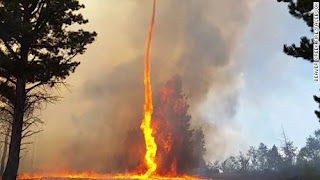Fire Tornado
Fire whirl, also commonly known as a fire devil, or, (in many cases
erroneously) as a fire tornado, firenado, fire swirl, or fire
twister, is a whirlwind induced by a fire and often (at
least partially) composed of flame or ash. These start with a whirl of wind, often made visible
by smoke,
and may occur when intense rising heat and turbulent wind conditions combine to
form whirling eddies of air. These eddies can
contract a tornado-like vortex that
sucks in debris and combustible gases.
Fire whirls
are sometimes colloquially called fire tornadoes, but are not usually
classi
fiable as tornadoes as the vortex in most cases does not extend from the
surface to cloud base. Also, even in such cases, those fire whirls very rarely
are classic tornadoes, as their vorticity derives
from surface winds and
heat-induced lifting, rather than from a tornadic mesocyclone aloft,
although a handful of suspected cases of the latter are known.
A
fire whirl consists of a burning core and a rotating pocket of air. A fire
whirl can reach up to 2,000 °F (1,090 °C). Fire whirls become
frequent when a wildfire, or especially firestorm,
creates its own wind, which can spawn large vortices. Even bonfires often
have whirls on a smaller scale and tiny firewhirls have been generated by very
small fires in laboratories.
Most of the
largest fire whirls are spawned from wildfires. They form when a warm updraft and
convergence from the wildfire are present.[4] They are usually
10–50 m (33–164 ft) tall, a few meters (several feet) wide, and last
only a few minutes. Some, however, can be more than 1 km (0.6 mi)
tall, contain wind speeds over 200 km/h
(120 mph), and persist for more than 20 minutes.
Fire whirls
can uproot trees that are 15 m (49 ft) tall or more. These can
also aid the 'spotting' ability of wildfires to propagate and start new fires
as they lift burning materials such as tree bark. These burning embers can be
blown away from the fireground by the stronger winds aloft.
Firewhirls
can be common within the vicinity of a plume during
a volcanic eruption. These range from small
to large and form from a variety of mechanisms, including those akin to typical
firewhirl processes, but can result in Cumulonimbus flammagenitus (cloud) spawning landspouts and waterspouts[9] or even to
develop mesoyclone-like updraft rotation of the plume itself and/or of the
cumulonimbi, which can spawn tornadoes similar to those in supercells.
Pyrocumulonimbi generated by large fires on rare occasion also develops in a
similar way.
An
extreme example of a fire whirl is the 1923 Great Kantō earthquake in Japan,
which ignited a large city-sized firestorm and produced a gigantic fire whirl
that killed 38,000 people in fifteen minutes in the Hifukusho-Ato region
of Tokyo.
Another
example is the numerous large fire whirls (some tornadic) that developed
after lightning struck
an oil storage facility near San Luis Obispo, California,
on 7 April 1926, several of which produced significant structural damage well
away from the fire, killing two. Many whirlwinds were produced by the
four-day-long firestorm coincident with conditions that produced severe thunderstorms,
in which the larger fire whirls carried debris 5 km (3.1 mi) away.
Firewhirls
were produced in the conflagrations and firestorms triggered
by firebombings of
European and Japanese cities during World War Two and
by the atomic bombings of Hiroshima and
Nagasaki. Firewhirls associated with the bombing of Hamburg,
particularly those of 27–28 July 1943, were studied.
Throughout
the 1960s-1970s, particularly in 1978-1979, firewhirls ranging from the
transient and very small to intense, long-lived tornadic-like vortices capable
of causing significant damage were spawned by fires generated from the
1000 MW Météotron,
a series of large oil wells located in the Lannemezan plain
of France used for testing atmospheric motions and thermodynamics.
During
the 2003 Canberra bushfires in Canberra,
Australia a violent firewhirl was documented. It was calculated to have
horizontal winds of 160 mph (260 km/h) and vertical air speed of
93 mph (150 km/h), causing the flashover of
300 acres (120 ha) in 0.04 seconds. It was the first known firewhirl
in Australia to have EF3 wind speeds on the Enhanced Fujita scale.
A fire
whirl, of reportedly uncommon size for New Zealand wildfires, formed on day
three of the 2017 Port Hills fires in Christchurch.
Pilots estimated the fire column to be 100 m (330 ft) high.
Residents in
the city of Redding, California, while evacuating the area
from the massive Carr Fire in late July 2018, reported
seeing pyrocumulonimbusclouds and tornado-like
behaviour from the firestorm, resulting in uprooted trees, cars, structures and
other wind related damages in addition to the fire itself. As of August 2,
2018, a preliminary damage survey, led by the National Weather Service (NWS)
in Sacramento, California rated the July 26th
fire whirl as an EF3 tornado with winds in excess of
143 mph (230 km/h).

Comments
Post a Comment